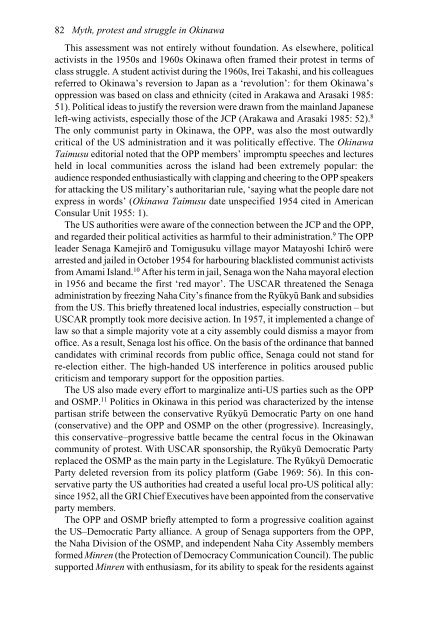Myth, Protest and Struggle in Okinawa
Myth, Protest and Struggle in Okinawa
Myth, Protest and Struggle in Okinawa
Create successful ePaper yourself
Turn your PDF publications into a flip-book with our unique Google optimized e-Paper software.
82 <strong>Myth</strong>, protest <strong>and</strong> struggle <strong>in</strong> Ok<strong>in</strong>awa<br />
This assessment was not entirely without foundation. As elsewhere, political<br />
activists <strong>in</strong> the 1950s <strong>and</strong> 1960s Ok<strong>in</strong>awa often framed their protest <strong>in</strong> terms of<br />
class struggle. A student activist dur<strong>in</strong>g the 1960s, Irei Takashi, <strong>and</strong> his colleagues<br />
referred to Ok<strong>in</strong>awa’s reversion to Japan as a ‘revolution’: for them Ok<strong>in</strong>awa’s<br />
oppression was based on class <strong>and</strong> ethnicity (cited <strong>in</strong> Arakawa <strong>and</strong> Arasaki 1985:<br />
51). Political ideas to justify the reversion were drawn from the ma<strong>in</strong>l<strong>and</strong> Japanese<br />
left-w<strong>in</strong>g activists, especially those of the JCP (Arakawa <strong>and</strong> Arasaki 1985: 52). 8<br />
The only communist party <strong>in</strong> Ok<strong>in</strong>awa, the OPP, was also the most outwardly<br />
critical of the US adm<strong>in</strong>istration <strong>and</strong> it was politically effective. The Ok<strong>in</strong>awa<br />
Taimusu editorial noted that the OPP members’ impromptu speeches <strong>and</strong> lectures<br />
held <strong>in</strong> local communities across the isl<strong>and</strong> had been extremely popular: the<br />
audience responded enthusiastically with clapp<strong>in</strong>g <strong>and</strong> cheer<strong>in</strong>g to the OPP speakers<br />
for attack<strong>in</strong>g the US military’s authoritarian rule, ‘say<strong>in</strong>g what the people dare not<br />
express <strong>in</strong> words’ (Ok<strong>in</strong>awa Taimusu date unspecified 1954 cited <strong>in</strong> American<br />
Consular Unit 1955: 1).<br />
The US authorities were aware of the connection between the JCP <strong>and</strong> the OPP,<br />
<strong>and</strong> regarded their political activities as harmful to their adm<strong>in</strong>istration. 9 The OPP<br />
leader Senaga Kamejirō <strong>and</strong> Tomigusuku village mayor Matayoshi Ichirō were<br />
arrested <strong>and</strong> jailed <strong>in</strong> October 1954 for harbour<strong>in</strong>g blacklisted communist activists<br />
from Amami Isl<strong>and</strong>. 10 After his term <strong>in</strong> jail, Senaga won the Naha mayoral election<br />
<strong>in</strong> 1956 <strong>and</strong> became the first ‘red mayor’. The USCAR threatened the Senaga<br />
adm<strong>in</strong>istration by freez<strong>in</strong>g Naha City’s f<strong>in</strong>ance from the Ryūkyū Bank <strong>and</strong> subsidies<br />
from the US. This briefly threatened local <strong>in</strong>dustries, especially construction – but<br />
USCAR promptly took more decisive action. In 1957, it implemented a change of<br />
law so that a simple majority vote at a city assembly could dismiss a mayor from<br />
office. As a result, Senaga lost his office. On the basis of the ord<strong>in</strong>ance that banned<br />
c<strong>and</strong>idates with crim<strong>in</strong>al records from public office, Senaga could not st<strong>and</strong> for<br />
re-election either. The high-h<strong>and</strong>ed US <strong>in</strong>terference <strong>in</strong> politics aroused public<br />
criticism <strong>and</strong> temporary support for the opposition parties.<br />
The US also made every effort to marg<strong>in</strong>alize anti-US parties such as the OPP<br />
<strong>and</strong> OSMP. 11 Politics <strong>in</strong> Ok<strong>in</strong>awa <strong>in</strong> this period was characterized by the <strong>in</strong>tense<br />
partisan strife between the conservative Ryūkyū Democratic Party on one h<strong>and</strong><br />
(conservative) <strong>and</strong> the OPP <strong>and</strong> OSMP on the other (progressive). Increas<strong>in</strong>gly,<br />
this conservative–progressive battle became the central focus <strong>in</strong> the Ok<strong>in</strong>awan<br />
community of protest. With USCAR sponsorship, the Ryūkyū Democratic Party<br />
replaced the OSMP as the ma<strong>in</strong> party <strong>in</strong> the Legislature. The Ryūkyū Democratic<br />
Party deleted reversion from its policy platform (Gabe 1969: 56). In this conservative<br />
party the US authorities had created a useful local pro-US political ally:<br />
s<strong>in</strong>ce 1952, all the GRI Chief Executives have been appo<strong>in</strong>ted from the conservative<br />
party members.<br />
The OPP <strong>and</strong> OSMP briefly attempted to form a progressive coalition aga<strong>in</strong>st<br />
the US–Democratic Party alliance. A group of Senaga supporters from the OPP,<br />
the Naha Division of the OSMP, <strong>and</strong> <strong>in</strong>dependent Naha City Assembly members<br />
formed M<strong>in</strong>ren (the Protection of Democracy Communication Council). The public<br />
supported M<strong>in</strong>ren with enthusiasm, for its ability to speak for the residents aga<strong>in</strong>st
















